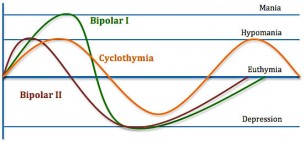Get your facts straight about Bipolar Disorder, one of the most common mental illnesses in the country.
Could you have a type of bipolar disorder? The reality is, you probably don’t, but having one is not as rare as you might think. On average, 5.7 million Americans are affected with bipolar disorder annually. Just over half seek treatment. If you’re interested in learning more, read on and find out how much you really know about bipolar disorders.
Myths
1) There is only one single bipolar disorder.
2) If you have a lot of mood swings, you have a bipolar disorder.
3) People with a bipolar disorder switch between moods constantly, maybe even multiple times in the span of a few minutes.
Now that we’ve shaken off a little of the stigma, and know that these common preconceptions are actually false, let’s take a look at how these sets of disorders actually present themselves.
Facts
What do all bipolar disorders have in common? The existence of a manic state, accompanied by a depressed state, is what characterizes all bipolar disorders. During a manic or a depressive episode, which could last from days to weeks at a time, a person usually experiences both mood and behavioral changes.
A manic episode entails feeling “high” or euphoric. While in some cases, manic episodes are endured blissfully, that is most often not the case, as people in this state usually become irritable and even aggressive. Additionally, their behavior might include excited speech or actions, racing thoughts, the ability to function on little amounts of sleep without feeling tired, and engaging in impulsive and risky behaviors, such as gambling, driving cars at high speeds, or using drugs. It is clear to see how this could be dangerous, not only to the person suffering from the disorder, but also to others around them.
In contrast, in a depressive episode, the person will typically feel sad, but will also show signs of hopelessness with herself and the world and will lose interest in activities that she once found pleasurable. Someone in a depressive episode might also show signs of fatigue, problems with concentration and memory, and changes in appetite, or they may have suicidal thoughts.
Taking these factors into consideration, there are several types of bipolar disorders. Bipolar 1 disorder is defined by its predominant feature: manic episodes. People suffering from this type of bipolar disorder are likely to have mostly manic tendencies, with the occasional depressive episode. The “opposite,” if you will, is what we categorize as Bipolar 2 disorder, meaning the defining feature is major depression, with less frequent manic episodes. Bipolar 1 and 2 represent the extremes; they are fully-fledged disorders. A less severe type of bipolar disorder does exist, and it is called Cyclothymic disorder. This illness entails the same effects as the aforementioned two, but its symptoms present themselves in a much less severe manner. Lastly, there are unspecified types of bipolar disorder, in case symptoms fall along similar lines, but do not fit the criteria for any one of these disorders.
Pictured below is a great visual representation of the severity of symptoms.
Treatment
So how do we treat this disorder? Before delving into treatments, we have to understand what causes these disorders to exist in the first place.
Although the onset of these disorders still isn’t completely clear, scientists have a few leads as to what some causal factors are. There is, in fact, a genetic predisposition to developing Bipolar 1. In many studies, researchers have found that someone is more likely to have this illness if someone else in her family has had it. Another biological factor is an imbalance of either norepinephrine or serotonin. These neurotransmitters are thought to be connected to mood, so an abundance of them could lead to manic episodes, while a deficiency could lead to depression. Some psychological factors thought to be associated with these illnesses are the occurrence of stressful life events, such as death or divorce. Keeping all these causal factors in mind, it is important to understand that there is no definitive test for diagnosing bipolar disorders.
In assessing proper treatment for these conditions, remember that there is no cure for these illnesses. There are, however, several long-term treatment options.
Before considering medication, many experts recommend that people suffering from bipolar disorders keep healthy, regular routines; these may include maintaining a regular sleeping schedule, getting regular exercise, minimizing caffeine intake, avoiding alcohol and other substances, and making sure not to take on too many responsibilities.
Aside from maintaining a healthy schedule, treatment most often includes mood stabilizers. As previously mentioned, bipolar disorders can be caused by imbalances in mood-charging hormones; thus, a medication to restore balance would be highly beneficial. Lithium is a common choice, although it has many side effects and must be closely monitored by a medical professional. It is also recommended that people seek therapy in conjunction with medication. Most often, cognitive-behavior therapy, which attempts to change harmful or negative thought patterns or behavior, is used. Of course, surrounding oneself with a positive environment of loved ones also helps.

Comments are closed